BOX SQUAT WARNINGJust like all exercises or activities there are safety procedures that should be followed with the Box Squat.By Dr Greg Shepard Published: Winter 2001 Over the last twenty years, I have heard of only a handful of athletes getting hurt on the Box Squat. That is quite remarkable when you consider the millions of repetitions performed by athletes over that time period. However, just like all exercises or activities there are safety procedures that should be followed with the Box Squat. To emphasize just how important, I would like to share part of the following letter I recently received: “I am a former collegiate baseball player and a high school football coach. In high school I was a very dedicated athlete. While others were out partying, I would invent and design ways to improve. Always looking for the edge. My high school did not employ the BFS principles but I did hear of a few that did. I noticed the difference. It is an awful feeling to be overpowered.” Bill, not his real name, went to a junior college to play baseball with the dream of playing in the major leagues. After his second year, he started doing some of the BFS Program and Box Squats. “I began to watch the ball jump off the bat and my acceleration increase. I was addicted the weight room and saw no limits. One day I loaded 185 pounds on the rack to warm up on the Box Squat for ten reps. I was so fired up I neglected CORRECT technique. Instead of controlling the weight and approaching the box gently, I was careless and in a hurry. On one of my reps, I banged at the bottom and felt a twinge in my spine, a day I or my body will never let me forget. I ended up having X Rays, MRI, CAT SCAN, nerve test, chiropractor and acupuncture done for my negligence. As I write I feel the discomfort from 12 years ago. You may share my story on how I was not careful.” I corresponded with Bill several times trying to get the full picture. There were a number of mistakes that were made which prompted my decision to write this article. I certainly do not want anyone else to go through what Bill went through. MISTAKE #1 Bill did not get the BFS Total Program book or watch our video to really know how to do a Box Squat with correct technique. He never got to attend a BFS Clinic. Bill says he neglected correct technique but, in fact, he did not really know correct technique. MISTAKE #2 Bill worked out in a public fitness gym. There were no teammates, no strength coach, no coach or no one around to help him do it right. Bill was on his own. Personal trainers at gyms are not likely to know how to Box Squat. MISTAKE #3 Bill stated, “I used a padded bench, one that is used for multi-uses like dumbbell work. When I sat on the bench my legs were parallel.” Bill should have used our BFS Squat Box. Athletes should do their first Box Squats at a height that is two inches above parallel. A parallel position on a bench is much more difficult to control and tougher to keep the lower back locked in properly.(See Figures #1, #2 and #3) BFS has a variety of different height boxes that can be adjusted to every three-fourths of an inch. Getting the right height on your box is critical in preventing potential injuries. MISTAKE #4 Bill combined programs. He used a university’s set-rep system and then used a BFS lift. Coaches who combine programs are almost always less successful. Bill should have used the BFS system which calls for less sets and less reps than he was doing(5 X 10). The most we ever do is 5 X 5 reps. A college male athlete would almost always warm-up with 225 not 185. Perhaps this is getting a little picky but if you are going to do a program, I feel you should do it exactly for at least a cycle before you start to tinker. You have the luxury of many years of BFS tinkering. The chances that you can come up with something better in doing our lift is slim because we have, in all likelihood, thought out your scenario thoroughly. MISTAKE #5 Bill said he did not control the weight and approach the bar gently. These are not the words we use to describe our approach to the Box Squat. Place the bar on your shoulders as shown in figure #4. Do not place the bar on your neck or down lower than shown. Do the six absolutes: Eyes on Target straight ahead, Be Tall, Spread the Chest, Knees Aligned, Toes Aligned and get into a Jump Stance to take the bar off the rack. Put some pressure on the bar once it is in place, Figure #5. Then get tight, take a deep breath and hold it. Now, take the bar off the rack aggressively by squatting straight up and breathe out some, Figure #6. Then, take two steps back to the box to get in position to squat, Figure #7. Not three, four or more; only two. All this time an aggressive attitude should prevail, not a gentle one. This helps prepare the entire body for what is to come. It is essential for injury prevention. When I coached football, I learned the hard way never to say, “OK men, we are going to do some half speed drills. Everyone had their own idea of what half speed meant. Some went 95%, some went 10%. That is dangerous. I use the same mentality when coaching the Box Squat. Have a controlled aggressive attitude. Be intense even on a warm-up. Don’t be gentle or go half way. MISTAKE #6 Bill says that he “banged” at the bottom. He also said that he was told to “relax at the bottom for one second.” Both of these actions are completely wrong. So wrong, in fact, that these actions, in my opinion, were the principal cause of Bill’s injury. The spotters and lifter must work together. The back spotter uses an overhand grip. Do not spot with your hands underneath the lifter’s armpits because an experienced back spotter can guide the lifter into a perfect groove (see Figure #8 and #9). Figure #10 shows Coach Shepard pulling slightly back on the bar which helps Matt settle back or rock back. However, notice that Matt continues to pay strict attention to the Six Absolutes. At no time should you relax for an instant . . . let alone for one whole second. You must “Be Tall” and stay erect. You must “Spread the Chest” at all times to keep the lower back locked into place. Figures #11 & #12 shows Matt rocking forward and up to complete the lift. You should even try to rise up on the toes at the very end to complete a full extension. It would be like a calf raise but done in a coordinated, fluid motion like a form tackle or jumping movement. Although, it is important to be in control. You would not want to take a light weight and jump up in the air. SOME OTHER MISTAKES Never round the lower back as shown in Figure #13. Always Be Tall and Spread the Chest as in Figure #14. Never take your feet off the floor or raise your heels off the floor when settling or rocking back as shown in Figure #15. (My son Matt is shown in the illustrations. He started with the BFS Readiness Program at the beginning of his 7th grade year. Matt is now 26 and works at BFS.) WHY WE BOX SQUAT The benefits of doing the Box Squat are enormous. So enormous they give anyone a distinct advantage over their opponents at every level: Junior High, High School, College and even at the Pro Level. We do two squat workouts as core lifts per week. One core lift, of course, is the Parallel Squat and the other core lift is a Squat Variation. The Squat Variation to start with is the Box Squat. An experienced lifter could use a Front Squat as a core lift Squat Variation. The Box Squat is the preferred lift to do during the season. There are five reasons why we Box Squat: REASON ONE: It’s Easy. The Box Squat is the easiest of all free weight exercises to do and to teach the Six Absolutes or proper lifting technique. Anyone can Box Squat with great form in the first day. Any inexperienced lifter at any level would benefit greatly by learning to Box Squat. Once you learn lifting technique on the Box Squat, you can better u |
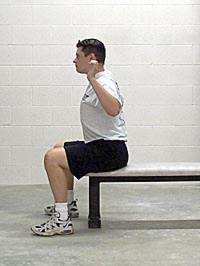 |
|
Figure #1 Parallel position is too low. |
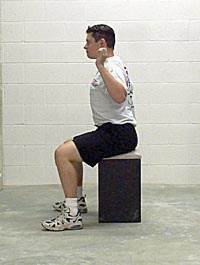 |
|
Figure #2 Two-inches above parallel is best. |
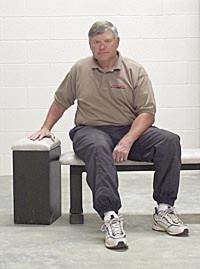 |
|
Figure #3 Coach Shepard shows the difference between a bench and medium squat box. |
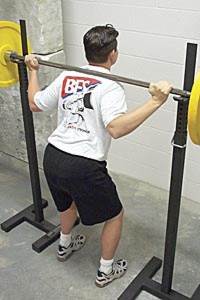 |
|
Figure #4 Place the bar on the shoulders. |
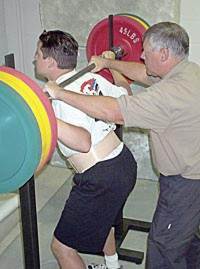 |
|
Figure #5 Put some pressure on the bar. |
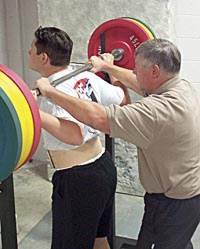 |
|
Figure #6 Aggressively stand straight up. |
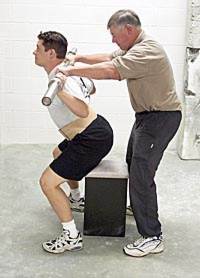 |
|
Figure #8 Do all Six Absolutes. Use a spotter with every lift. |
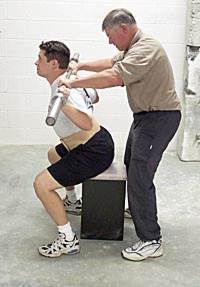 |
|
Figure #9 Sit on the Box under control. Spotter helps squatter with control. |
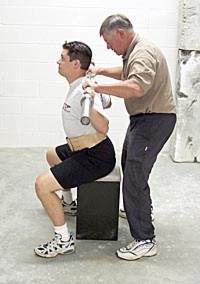 |
|
Figure #10 Spotter helps the lifter settle back by pulling back slightly on the bar. |
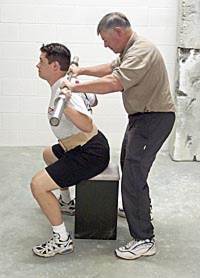 |
|
Figure #11 Rock back using the hips and hip tendons. |
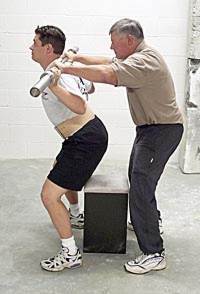 |
|
Figure #12 And up. Rise up on the toes at the very end. |
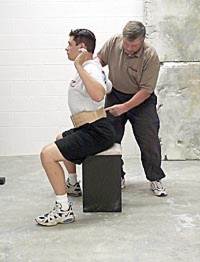 |
|
Figure #14 Always Be Tall and Spread the Chest to lock-in the lower back. |
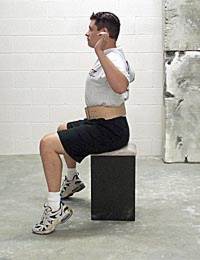 |
|
Figure #15 Never lift feet off the floor or raise the heels. |
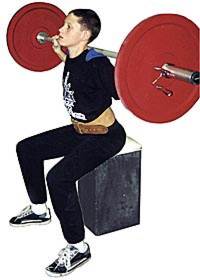 |
|
Figure #16 The BFS Six Absolutes 1. Eyes on Target, 2. Spread the Chest, 3. Be Tall, 4. Lock-In Lower Back, 5. Knees Over Toes, 6. Use an Athletic Stance |